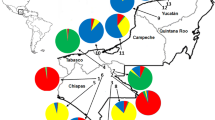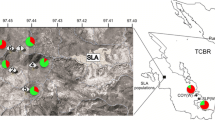Abstract
Studies about the organization of the genetic variability and population structure in natural plant populations are used to support conservation and management programs. Among the Cerrado fruit tree species that possess potential economic importance in agriculture, the “Cagaiteira” (Eugenia dysenterica DC. – Myrtaceae), deserves an special position. We obtained information about allele and genotypic frequencies in 10 local populations, situated up to 250 km apart, from six isozymes that furnished a total of 8 loci. The average within-population fixation index (f) was 0.337, and the out crossing rate was 0.835, suggesting a mixed mating system for this species, which seems to be preferably alogamous. Based on genetic diversity and analysis of variance techniques, a high degree of population differentiation (θP = 0.154) was found, in comparison with other tropical tree species. Genetic divergence, analyzed by Nei's genetic distances, clustered with UPGMA and ordinated by non-metric multidimensional scaling, showed spatial patterns of clusters of local populations. Explicit spatial analyses, using Mantel tests and boundary tests, basically confirmed these patterns and revealed a complex pattern of genetic variation in geographic space. The intercept of the multivariate spatial correlograms was around 120 km, an indication of the minimum distance between samples needed to conserve genetic diversity among samples. This spatial scale can be used to define population genetics units for conservation programs or to establish sampling strategies.
Similar content being viewed by others
References
Almeida SP, Silva JÁ da, Ribeiro, JF (1987) Aproveitamento alimentar de espécies nativas dos cerrados: araticum, barÚ, cagaita e jatobá. EMBRAPA-CPAC, Planaltina.
Avise JC (2000) Phylogeography. Harvard University Press, Cambridge, Massachussets.
Avise JC, Hamrick JL (1996) Conservation Genetics: Case Histories from Nature. Chapman &; Hall, London.
Borém A (1998) Melhoramento de Plantas, 2nd edn. Editora da UFV, Viçosa.
Carthew SM (1993) Population genetic structure of Banksia spinulosa. Heredity, 70(6), 566–573.
Crandall KA, Bininda-Emonds ORP, Mace GM, Wayne RK (2000) Considering evolutionary processes in conservation biology. Trends in Ecology and Evolution, 15, 290–295.
Dias LAS, Kageyama PY (1991) Variação genética em espécies arbóreas e conseqüências para o melhoramento florestal. Agrotrópica, 3(3), 119–127.
Diniz-Filho JAF, Telles MPC (2002) Spatial autocorrelation analysis and the identification of operational units for conservation in continuous populations. Conserv. Biol., 16, 924–935.
Donadio LC, Martins ABG, Valente JP (1992) Fruticultura Tropical. FUNEP, Jaboticabal.
Felsenstein J (1993) PHYLIP 3.5 —Phylogeny Inference Package. University of Washington, Seattle.
Ferreira MB, Cunha LHdeS (1980) Dispersão de Plantas lenhosas de cerrado — germinação e desenvolvimento. Inf. Agropec., 6(6), 27–32.
Fonseca Agda, Muniz IAdeF (1992) Informações sobre a cultura de espécies frutíferas nativas da região de cerrado. Inf. Agropec., 16(173), 12–17.
Fraser DJ, Bernatchez L (2001) Adaptive evolutionary conservation: Towards a unified concept for defining conservation units. Molecular Ecology, 10, 2741–2752.
Hamrick JL, Godt JW (1990) Allozyme diversity in plant species. In: Plant Population Genetics, Breeding and Genetic Resources (eds. Brown ADH, Cleg MT, Kahler AL, Weir BS), pp. 43–63. Sinauer, Suderland, Massachusetts.
Hamrick JL, Linhart YB, Mitton JB (1979) Relationships between life history characteristics and electrophoretically detectable genetic variation in plants. Ann. Rev. Ecol. Syst., 10, 173–200.
Hamrick JL, Loveless MD (1989) The genetic structure of tropical tree populations: associations with reproductive biology. In: The Evolutionary Ecology of Plants (eds. Bock JH, Linhart YB), pp. 129–146. Westview Press, Boulder.
Hamrick JL, Nason JD (1996) Consequences of dispersal in plants. In: Population Dynamics in Ecological Space and Time (eds. Rhodes JrOE, Chesser RK, Smith MH). Chicago, The University of Chicago Press.
Hedrick PW (2001) Conservation genetics: Where are we now. Trends in Ecology and Evolution, 16, 629–638.
Heywood JS, Fleming TH (1986) Patterns of allozyme variation in three tropical species of Piper. Biotropica, 18, 208–213.
Legendre P, Legendre L (1998) Numerical Ecology. Elsevier, Amsterdam.
Lessa E (1990) Multidimensional analysis of geographic genetic structure. Syst. Zool., 39, 242–252.
Lewis PO, Zaykin D (2001) Genetic Data Analysis: Computer program for the analysis of allelic data. Version 1.0 (d16c). Free program distributed by the authors over the internet from http://lewis.eeb.uconn.edu/lewishome/software.html
Loveless MD, Hamrick JL (1984) Ecological determinants of genetic structure in plant populations. Ann. Rev. Ecol. Syst., 15, 65–95.
Lynch M (1996) A quantitative-genetic perspective on conservation issues. In: Conservation Genetics: Case Histories from Nature (eds. Avise JC, Hamrick JL), pp. 471–501. Chapman &; Hall, London.
Manel S, Schwartz MK, Luikart G, Taberlet P (2003) Landscape genetics: Combining landscape ecology and population genetics. Trends in Ecology and Evolution, 15, 290–295.
Manly BFJ (1985) The Statistics of Natural Selection. Chapman &; Hall, London.
Manly BFJ (1986) Randomization and regression methods for testing for associations with geographical, environmental and biological distances between populations. Res. Pop. Ecol., 28, 201–218.
Manly BFJ (1997). Randomization, Bootstrap and Monte Carlo Methods in Biology. Chapman &; Hall, London.
Moran GF, Muona O, Bell JC (1989) Breeding systems and genetic diversity in Acacia auriculiformis and A. crassicarpa. Biotropica, 21, 250–256.
Moritz C (1994) Defining “evolutionarily significant units” for conservation. Trends in Ecology and Evolution 9, 373–375.
Myers N, Mittermeier RA, Mittermeier CG, Fonseca GAB, Kent J (2000) Biodiversity hotspots for conservation priorities. Nature, 403, 853–858.
Nei M (1972) Genetic distance between populations. Amer. Nat., 106, 283–292.
Newton AC, Allnutt TR, Gillies ACM, Lowe AJ, Ennos RA (1999) Molecular phylogeography, intraspecific variation and the conservation of tree species. TREE, 14(4), 140–145.
Paetkau D (1999) Using genetic to identify intraspecific conservation units: A critique of current proposals. Conserv. Biol., 13, 1507–1509.
Petit RJ, Mousadik Ael, Pons O (1998) Identifying populations for conservation on the basis of genetic markers. Conserv. Biol., 12, 844–855.
Pitel JA, Cheliak WM (1984) Effect of Extraction Buffers on Characterization of Isoenzymes from Vegetative Tissues of five Conifer Species; a User's Manual. National Forestry Institute, Canadian Forestry Service, Petawawa.
Proença CEB, Gibbs PE (1994) Reproductive biology of eight sympatric Myrtaceae from Central Brazil. New Phytol., 126, 343–354.
Ritland K (1990) A series of FORTRAN computer programs for estimating plant mating systems. Journal of Heredity, 81, 235–237.
Ritland K, Jain S (1981) A model for the estimation of outcrossing rate and gene frequencies using n independent loci. Heredity, 47(1), 35–52.
Rodrigues FM, Diniz-filho JAF (1998) Hierarchical strtucture of genetic distances: Effects of matriz size, spatial distribuition and correlation strtucture among gene frequencies. Genetics and Molecular Biology 21(2), 233–240.
Rohlf FJ (1989) NTSYS-Pc: Numerical Taxonomy and Multivariate Analysis System. Exeter Publishers, New York.
Smouse PE, Long JC, Sokal RR (1986) Multiple regression and correlation extensions of the Mantel test of matrix correspondence. Syst.Zool., 35, 627–632.
Sokal RR (1979) Ecological parameters inferred from spatial correlograms. In: Contemporary Quantitative Ecology and Related Econometrics (eds. Patil GP, Rosensweig, ML), pp. 167–196. International Co-operative Publishing House, Maryland.
Sokal RR (1986) Spatial data analysis and historical processes. In: Data Analysis and Informatics IV. (eds. Diday E et al.), pp. 29–43. Science Publishers, Amsterdam.
Sokal RR, Oden NL (1978a) Spatial autocorrelation in biology. 1. Methodology. Biol. J. Linn. Soc., 10, 199–228.
Sokal RR, Oden NL (1978b) Spatial autocorrelation in biology. 2. Some biological implications and four applications of evolutionary and ecological interest. Biol. J. Linn. Soc., 10, 229–249.
Swofford DL, Olsen GJ, Waddell PJ, Hillis DM (1996) Phylogeny inference. In: Molecular Systematics, 2nd edn. (eds. Hillis DM, Moritz C, Marble BK), pp. 407–514. Sinauer Associates, Sunderland, Massachussets.
Telles MPC, Silva RSM, Chaves LJ, Coelho ASG, Diniz-Filho JAF (2001) Divergência entre subpopulações de cagaiteira (Eugenia dysenterica) em resposta a padrões edáficos e distribuição espacial. Pesq. Agropec. Bras., 36, 1387–1394.
Wartenberg D (1989) SAAP: Spatial Autocorrelation Analysis Program. Exeter Publishers, New York.
Weir BS (1996) Genetic Data Analysis II. Sinauer Associates, Sunderland, Massachussets.
Author information
Authors and Affiliations
Corresponding author
Rights and permissions
About this article
Cite this article
de Campos Telles, M.P., Coelho, A.S.G., Chaves, L.J. et al. Genetic diversity and population structure of Eugenia dysenterica DC. (``cagaiteira'' – Myrtaceae) in Central Brazil: Spatial analysis and implications for conservation and management. Conservation Genetics 4, 685–695 (2003). https://doi.org/10.1023/B:COGE.0000006124.55109.5e
Issue Date:
DOI: https://doi.org/10.1023/B:COGE.0000006124.55109.5e




